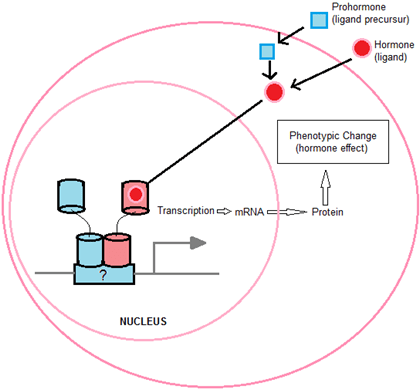This set of Molecular Endocrinology Multiple Choice Questions & Answers (MCQs) focuses on “Nuclear Receptor Ligands – Set 2”.
1. What is the role of the activated nuclear receptor xenobiotics?
a) Induce cytochrome P450
b) Induce cytochrome P30
c) Induce cytochrome P50
d) Induce cAMP
View Answer
Explanation: Nuclear receptors like normal endobiotic and xenobiotics, tend to act as integrators of exogenous environmental signals. The function of the activated nuclear receptor in these cases is to induce the cytochrome P450 enzyme that promotes the detoxification of potentially hazardous liver compounds.
2. Which receptor is otherwise known as pregnane X receptor (PXR)?
a) Peroxisome proliferator-activated receptors (PPARs)
b) Sterol and xenobiotic receptor (SXR)
c) Retinoid X receptor (RXR)
d) Liver X receptor (LXR)
View Answer
Explanation: Sterol and xenobiotic receptors (SXR), is otherwise known as pregnane X receptors (PXR). Xenobiotic receptors have low affinity for a wide range of ligands, unlike other nuclear receptors that have high affinity for very particular ligands.
3. Which is the nuclear receptor that act as a regulator of circadian rhythms?
a) Nuclear receptor NR3D1
b) Nuclear receptor NR1D2
c) Nuclear receptor NR1D1
d) Nuclear receptor NR2D1
View Answer
Explanation: A molecular heme receptor called the nuclear receptor NR1D1 (formerly named Rev-Erbal), is a regulator of circadian rhythms. The coordination of circadian rhythms and metabolism are carried out by this hormone.
4. Receptors other than nuclear receptor superfamily have been designated as orphan receptors.
a) True
b) False
View Answer
Explanation: One of the main families of transcription factors is the superfamily of nuclear receptors. Since its putative ligands are not identified, the remaining receptors have been classified as orphan receptors.
5. Hormone receptor mutations that occur naturally can cause hormone resistance in patients affected.
a) True
b) False
View Answer
Explanation: In affected patients, naturally occurring mutations of hormone receptors can cause hormone resistance. Hormone tolerance phenotype inheritance is dominant if the activity of the regular receptor is blocked by the mutant receptor.
6. Which among the following nuclear receptors lack a classic DNA-binding domain?
a) NR1D1
b) NROB1
c) NROB6
d) NR1D2
View Answer
Explanation: A classic DNA-binding domain lacks in certain naturally occurring variant nuclear receptors. These involve the mutant human disorder NROB1 (formerly known as DAX1) and PTPN6 (formerly known as SHP1).
7. Which among the following nuclear receptor ligand is enzymatically converted from inactive prohormones to biologically active hormones?
a) 5′ deiodination of thyroxine (T4)
b) NR3A
c) NR3C3
d) NR1A
View Answer
Explanation: Many of the ligands of the nuclear receptor are enzymatically converted to biologically active hormones from inactive prohormones. Examples involve the modification of 5′ thyroxine deiodination (T4) to triiodothyronine deiodination.
8. Which among the following hormones can act as a precursor molecule for the synthesis of another hormone?
a) FSH
b) Glucagon
c) Insulin
d) Testosterone
View Answer
Explanation: In certain cases, some hormones can act as precursors of another hormone. Example is the aromatization of testosterone to estradiol which is an estrogen hormone. Testosterone is a hormone that the human body produces. It’s mainly developed by the testicles in men.
9. In the diagram given below, which is the molecule that act as the precursor in the mechanism of signal transduction by hormones?

a) Hormone-responsive gene
b) Prohormone
c) Messenger RNA
d) Hormonal ligand
View Answer
Explanation: Multifunctional proteins transducing the signals of their cognate ligands are called nuclear receptors. The basic properties of signaling nuclear receptors are illustrated in the diagram. Here, Hormone-responsive gene act as the precursor in the mechanism of signal transduction by hormones.
10. Which enzyme causes the renal deactivation of cortisol?
a) Alcohol dehydrogenase
b) 11β-hydroxysteroid dehydrogenase
c) Lyase isomerase
d) Aromatase 3-oxidase
View Answer
Explanation: Renal deactivation of cortisol is caused by 11β-hydroxysteroid dehydrogenase enzyme. Enzyme activity reduction due to gene mutations or pharmacological agents can result in hormone excess symptoms.
Sanfoundry Global Education & Learning Series – Molecular Endocrinology.
To practice all areas of Molecular Endocrinology, here is complete set of 1000+ Multiple Choice Questions and Answers.
If you find a mistake in question / option / answer, kindly take a screenshot and email to [email protected]
